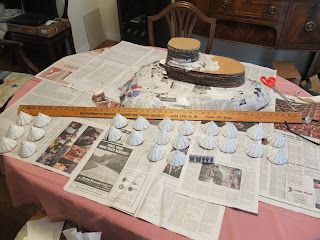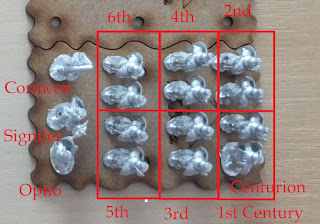The central Heartland Provinces:
Jharkor, Dharijor and Dharjiin,
Tharkallan Empire
It has been awhile since I last posted, but that does not mean that I have been entirely idle. I've been plugging away at a variety of things: my Armatura rules, background development and map-making.
The above screencap shows some of the recent progress in three of the central "Heartland" Provinces of the Tharkallan Empire. Some may recognize Nemedia Province, to the east, with Belverus and Ilisi as its main cities. South of that is Voria Province, with Rinliddi as its capital, and also featuring Zoria, the "City of Free Love". As with so much of my inspiration, this comes from Glorantha, specifically the
Life of Moonson series of supplements. I was so taken by the plot and by the characters that I have gone to great lengths to incorporate them. My hope is to build them into the running of Tharkalla - the development of my nobility, and Imperial bureaucracy, took a great leap forward when I decided to do this.
Southeast of Voria, down next to Vonlath, the province of Bisset is still largely unmapped. The only things I really know about it is 1) the capital is Yuthuppa and 2) that the province went into revolt as a result of the Comet passing during
The Year of the Comet.
Southwest of Voria is the Heartland Province of Jharkor, with the capital city of Thark (and the Imperial City-within-a-City of Glamour, and Vernkor, the associated port city.)
I've added some geographic features not shown on my world maps. The Lake of Vermillion Mists is inspired by a blogger that I follow, and is lifted, not quite in its entirety from his blog:
From the Sorcerer's Skull.
West of Jharkor is the Heartland Province of Dharjiin, with Jord, the Ebon City, as its capital. This is where I was tinkering today, adding the Shadow's Dance, the Shadow Vale and the Castle of Lead. All lifted from Glorantha and all Troll-related. Gloranthan Trolls remember - not the D&D variety!
North of Dharjiin is the Heartland Province of Dharijor, with Alkoth as its capital. Alkoth is the home, just as it is in Glorantha, to the bat-shit crazy, fanatical devotees of Shargash the Destroyer, God of War. What are they like? Hint: "Kill You" is the name of one of their auxiliary cohortes. Per Glorantha fluff, the Alkothi hate Darjiini! No "Happy Families" in the Heartlands! South of Alkoth is the Henjarl, a vast swath of reeds and marshes. Western Dharijor is the County of Spol, again inspired by Glorantha and specifically by the Life of Moonson Characters. Kitor is the capital of the County. To the west of that is Shadow's Dance, Troll country, nestled in the Rockwood Mountains. As one approaches the Shadow's Dance one notices the light gradually dims, even at high noon, until around Kitor and in the foothills there is perpetual dusk during the day. This is a magical effect and is attributed to the proximity to the Castle of Lead and the strong Troll presence in the region. For those that don't know, Gloranthan Trolls are Darkness creatures, originating in the Underworld. There are five Elements in Lohwand, just as there are in Glorantha: Fire, Air, Water, Earth, and Darkness. Darkness Elementals are called "Shades" and Shadow's Dance gets its name because it is said the shadows move there.
On the far side of the Rockwood mountains are the two Heartland Provinces of Kostaddi (in the North) and Karasal (with its capital at Torquas) in the South. I have only begun to think about developing these areas.
Also of interest on the map are some small diamond-shaped symbols. I am using this symbol to represent forts. In Dharjiin, Jharkor and Voria these are Amazon hillforts.
These are once again inspired in part by Glorantha. In Lohwand Amazons are somewhat like Celts, warlike tribes with chariots and warbands of infantry and only a few cavalry. Though they resemble human females they are not, strictly speaking, human; or not entirely so, perhaps, is a better way of putting it. Possibly they are a branch of humanity. As in Glorantha they are strongly associated with Tolat, a God of War and Lust. Their entire biology relates to the God, and so it may be they are Children of the God, rather than actual humans. "God-Born", is that a good term to use?
(To further complicate matters Shargash and Tolat are often equated with each other.)
Tolati Amazons do not mate with human males. Instead their birth cycle is tied to the meteor showers, i.e. manifestations of the God, that occur twice a year. A certain number of Tolati will become pregnant during these events and will give birth a season later, with the young growing to maturity after another season.
Like I said, they are not human, strictly speaking. Whether they were in the past is another question. Of course, the Comet is an extreme event, being strongly associated with Tolat and resulting in a rapid [unlooked for and unwanted] population increase.
Most of the Tolati Amazons are in the Atlan Confederacy, to the east, off the map: Ologog, Oronin and Oraya are their Queendoms. But, as you can see, there are Tolati within the Empire as well. This roughly parallels the Gauls in Northern Italy during Roman times.
For figures I am using the Artizan Guild 3d printed Amazons, which I am up-scaling 185% to match my Expeditionary Force 60mm Romans. Note that LOD also make Amazons, but a number of things put me off. Firstly, when I attempted to order a bunch the online store claimed they could not ship to Canada (!) - this even though I had ordered online once before - and second, the poses are all based very closely on the art of various Ancient Greek vases. I said "very closely" and I mean it - I personally do not find many of the poses to be that useful. I am still going to get some: there is an Amazon Greek faction on Lohwand, and I want to mix the horse archers in with my Scythians.
Another mapping development is the mountainous barbarian land of Dunland. Inspired by? You guessed it: Tolkien's Dunlendings. Dunland is located on a plateau and consists of several tribes with a High King. The eastern tribal stronghold of Wintertop was stolen and taken over by The Exiles, the former nobility of Nemedia who fled there when their kingdom was conquered and incorporated into the Tharkallan Empire as Nemedia Province. This is once again inspired by Glorantha. :-)
Dunland
Dorastor and the Bossonian Marches
Lastly, here is the map of Dorastor. Gloranthaphiles will recognise the name as well. In Glorantha, Dorastor is a region steeped in Chaos, and most of the inhabitants are tainted by Chaos in some way, and so it is in Lohwand.
The Tharkallan Empire takes much the same view of Chaos as the Lunar Empire does on Glorantha, though I want to stress that the two are not equivalents. I want the Tharkallan Empire to also have a bit of Granbreton from Michael Moorcock's Hawkmoon series, and also Melnibone from his Elric books. But right now, this is a bit of its Gloranthan inspiration.
Dorastor is almost an unofficial province of the Empire. But the Bossonian Marches still exist to guard against the Chaos threat from Dorastor and also the Wenelian Forest Tribes that dwell in the Great Forest of Rist, off-map to the north.
This is a work-in-process map. Shown are the forts garrisoned by auxiliaries like the Bossonian Longbowmen, and others. The southern river is the Oslir River, while the Black Eel River is the northern-most one. Beyond the Black Eel River is the Bush Range - another idea borrowed from Glorantha.
Here are the regions:
The Bossonian Marches
B1.1 to B1.6 East March
B2.1 to B2.x River March (not shown yet)
B3.1 to B3.x West March (not shown yet)
B4.1 to B4.x The Bush Range (not shown yet)
Dorastor
D1.1 to D1.8 Hellwood
D2.1 to D2.6 Riskland
D3.1 to D3.3 Bonewood
D4.1 to D4.3 Ash Wastes
D5.1 to D5.5 West Poisonthorn
D6.1 to D6.5 East Poisonthorn
Orthanc
The Dorastor regions are much like their Gloranthan counterparts. Hellwood and Poisonthorn Forest are both inhabited by Elves, those in Hellwood bearing a chaos taint. Riskland is a region with a few hardy, and brave, Steaders. Bonewood is a forest of petrified trees, while the Ash Wastes is as the name implies.
Orthanc represents the only built-up area in the region, other than the Marcher Forts. Also called "The White Tower", it is a remnant of the Keoish Kingdom at a time when Chaos was thought vanquished from the area, but to guard against its return. It is still a place of powerful magic and so the chaos taint is almost nonexistent within its walls.
The Lord of Orthanc is called Ralzakark - immediately recognizable to Gloranthaphiles! He takes the form of a Unicorn-headed Broo, typically clad in long white robes, and is as soft-spoken, and seemingly mild-mannered as any pampered, city-born aristocrat. He has a treaty with the Tharkallan Empire:
- Under that treaty he ensures that the Riskland homesteaders are not molested - at least not on a regular basis, nor by any of his own forces.
- He also keeps open the old Keoish trade route north through the Great Forest of Rist, at least as far as the Last Fort, where some limited trade is conducted with Wenelian, and other forest tribes, such as the Tusk Riders.
- He guarantees that Orthanc remains disease free.
- Lastly - and this is not commonly known - he supplies legions of Sword Broo to serve in the Tharkallan armies in Granbreton. These are also guaranteed disease-free.
This is why I referred to Dorastor as an unofficial province of the Empire. This is all pretty much as in Glorantha, I think, with some tweaks here and there.

































































